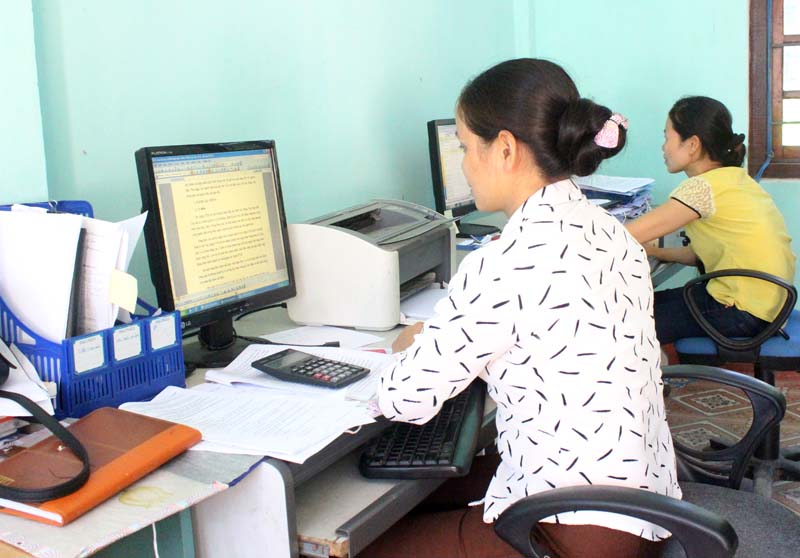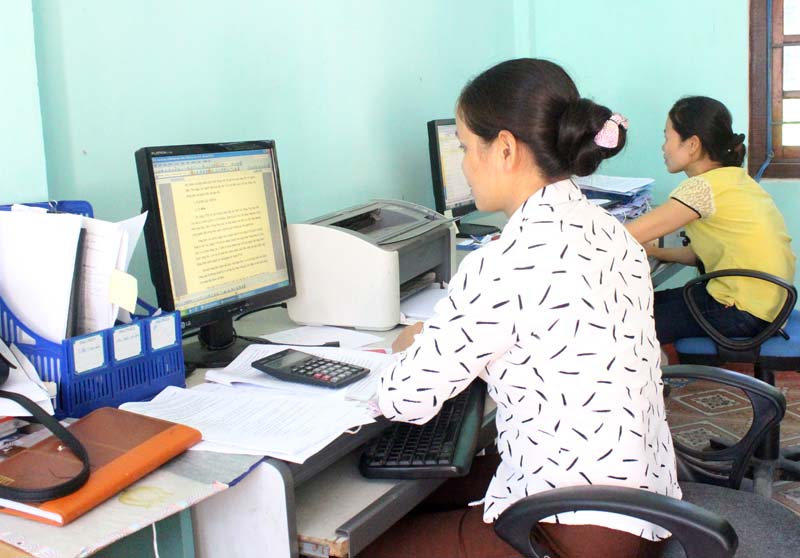
HBO - As a result of Hoa Binh’s emulation movement to a build lifelong learning society, nearly 68 percent of rural workers have learned knowledge and skills, and technology transfer at community learning centres. Meanwhile, 93 percent of the workers have engaged in vocational training, and more than 75 of them belong to the highly skilled workforce of the province’s spearhead economic sectors.
 Officials in the
difficult commune of Lac Sy (Yen Thuy) actively learn and apply IT to improve
their work efficiency.
Officials in the
difficult commune of Lac Sy (Yen Thuy) actively learn and apply IT to improve
their work efficiency.
Illiterate eradication and education universalisation are
the first goals set for the construction of a learning society. Therefore, over
the past time, all levels and branches in the province have come up with
effective solutions to organise literacy classes for adults. As a result, by
the end of 2018, the rate of people aged 15-60 years old with literacy level 1
in the entire province reached 99.65 percent; and those of the same age group
with literacy level 2 reached 97.68percent. Meanwhile, the rate of people aged
15-35 years old with literacy level 1 reached 99.92 percent. All of its 11
districts and cities met standards on the preschool universalisation for
5-year-old children, the secondary educational univesalisation level 2, and
illiterate eradication level 2. The rate of attendance at the right age for
primary and secondary education reached 100 percent, with 80 percent of
children with disabilities, who are in primary school age, attending school.
Quach The Tan, Chairman of the provincial Study
Encouragement Association, highlighted that for adults, the movement focuses on
improving the competence level of computer, foreign languages, professional,
and labour skills.
The lifelong learning campaign also promotes sharpening life
skills, and building a better personal and community life. In the past five years,
life skills teaching as part of academic education, particularly via
extra-curricular activities, have attracted the participation of 94.3 percent
of local students.
The quality of learning centres in Hoa Binh’s communes,
wards and towns has been continuously improved, creating favorable learning conditions
for many people, especially the rural workforce, women and people with
disadvantaged backgrounds.
The emulation movement "Hoa Binh joining hands to build new-style rural areas” has been widely spreading, becoming a driving force that motivates the localities to renew rural landscapes and improve the material and spiritual lives of the residents. In this movement, the people play a central role-both as the main implementers and direct beneficiaries of its outcomes.
In response to the global digital revolution, Hoa Binh Newspaper is transforming itself into a modern and multi-platform media hub, blending cutting-edge technology with a restructured newsroom and a new generation of tech-savvy journalists.
Hoa Binh province’s Association of the Elderly recently held a conference to review the project on expanding the inter-generation self-help club model until 2025.
In a move to implement Resolution No. 57-NQ/TW, issued on December 22, 2024 by the Politburo, which targets breakthroughs in science-technology development, innovation, and digital transformation, the Hoa Binh provincial Department of Health has issued a plan to roll out the "Digital Literacy for All” campaign within the local health sector.
An Nghia Commune (Lạc Sơn District) is one of the communes that achieved the tha standard of the national new rural area in 2018. Entering a new development phase, the commune is now trying to meet the criteria for the advanced new rural development. With the strong political will and the public consensus, the commune is gradually overcoming the challenges to reach this goal, aiming for the sustainable development.



 Officials in the
difficult commune of Lac Sy (Yen Thuy) actively learn and apply IT to improve
their work efficiency.
Officials in the
difficult commune of Lac Sy (Yen Thuy) actively learn and apply IT to improve
their work efficiency.